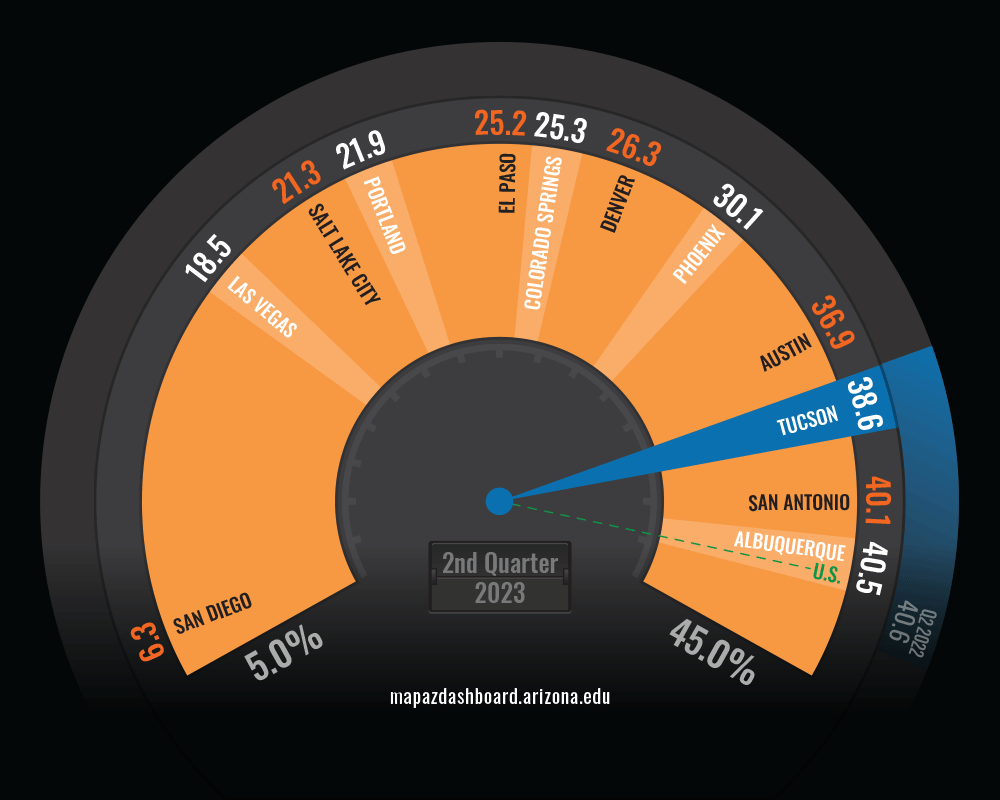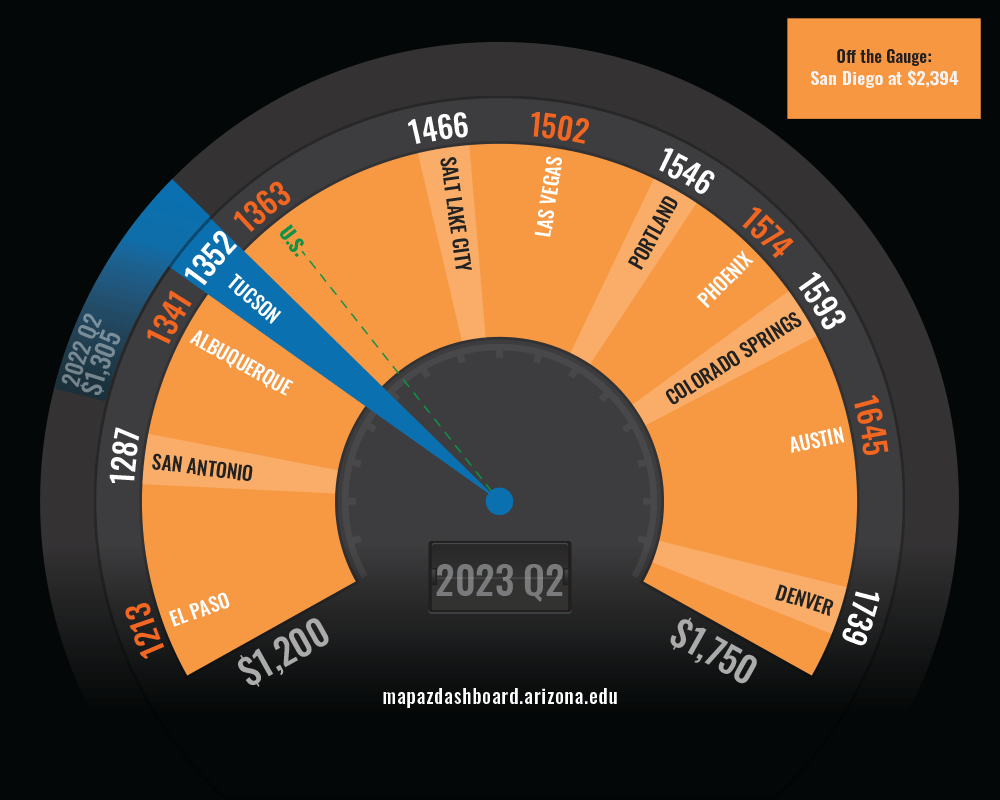 Housing Affordability Near Record Lows in Tucson, Arizona MSA
Housing Affordability Near Record Lows in Tucson, Arizona MSA
After improving in the first quarter of 2023, housing affordability dropped to near-record lows in the second quarter of 2023 for the Tucson Metropolitan Statistical Area (MSA). Tucson ranked third among peer MSAs, behind Albuquerque and San Antonio, with 38.6% of homes sold in the second quarter of 2023 considered affordable to a family earning the local median income (Figure 1). That was just 3.6 percentage points above the record low of 35.0% in the fourth quarter of 2022. Housing affordability in San Diego remains dismal compared to many of the MSAs tracked on the MAP, with only 6.3% of homes sold in the second quarter of 2023 considered affordable.
Figure 1: Housing Affordability 2nd Quarter 2023

Tucson’s housing affordability was more than 35 percentage points lower than just three years ago. Housing affordability in Tucson and across the nation declined significantly over the past three years due to home prices and mortgage interest driving up housing costs at a much faster pace than wages. However, wages in Tucson increased at the fastest rate since the Great Recession in 2019 and 2020, somewhat limiting the damage.
The MAP tracks annual housing affordability data back to 2000. Tucson posted the highest percentage of affordable homes in 2012, at 86.2%. Between the first quarter of 2012 and the second quarter of 2023, housing affordability in Tucson declined by 47.3 percentage points. Las Vegas posted the steepest decline during that period, at 70.8 percentage points, followed by Colorado Springs and Salt Lake City at 63.0 and 62.9, respectively. San Antonio posted the smallest decline at 36.7 percentage points. Nationally, housing affordability declined by 38.3 percentage points during that time. Figure 2 illustrates the change in the percent of homes sold each quarter that were considered affordable to someone earning the local median family income.
Figure 2: Housing Affordability Trend
Affordable housing is important because it affects homelessness and household spending in other areas such as childcare, education, health care, and leisure activities. Affordability isn’t just an issue for homeowners. Renters in the Tucson MSA have a much higher rate of housing cost burden than do homeowners, 21.3% vs 51.2%. Housing cost burden is another way to measure the financial stress housing places on residents. Housing cost burden measures the percentage of households that pay more than 30% of their income in housing-related costs. Cost-burdened households are more likely to struggle with paying for basic necessities.
In the second quarter of 2023, the average monthly rent for one-and-two bedroom apartments in the Tucson MSA hit an all-time high of $1,352, according to data from Apartment List (Figure 3). That was an increase of $47 or 3.6% over the year. Nationally, monthly rent reached a peak of $1,383 during the third quarter of 2022, but as of the second quarter of 2023 has declined slightly to $1,363. San Diego posted the highest rent at $2,394, nearly $700 higher than Denver, which had the second-highest average monthly rent at $1,739. El Paso posted the lowest average monthly rent at $1,213.
Figure 3: Average Rent of One-and-Two Bedroom Apartments (2nd Quarter 2023)

Rent in Tucson increased by a staggering 17.1% between 2020 and 2021 and rose by another 14.8% in 2022. Despite the rapid increase, Tucson’s overall rent price remained relatively low compared to peer western metros. Between January and July of 2023, rent declined for half of the MSAs tracked, while Tucson’s rent grew by 2.6% (Figure 4). Las Vegas and Phoenix posted the largest decline in average rent prices between 2022 and the second quarter of 2023 at 3.4% and 3.3%, respectively.
Figure 4: Growth Rate in Annual Average Rent for One-and-Two Bedroom Apartments
Nationally, the median sales price of single-family homes reached an all-time high of $412,700 in the second quarter of 2022. That trend held for nearly all the MSAs tracked on the MAP except El Paso, which reached their all-time high in the fourth quarter of 2022. Tucson’s median home price peaked at $380,700 during the second quarter of 2022. It subsequently fell during the third and fourth quarters of 2022 and the first quarter of 2023, settling at $362,600. This trend was consistent across Tucson’s peer MSAs and the nation. Nationally, prices fell by 10.1% during this time, while Austin saw the largest decline at 23.7%. Albuquerque and Tucson posted the smallest declines at 3.0% and 4.8%, respectively.
Home prices increased at a rapid rate in 2021 and the beginning of 2022 as strong demand met limited supply and rising construction costs. Home prices began to cool in the second half of 2022 due to spiking interest rates. However, recent data for Tucson during the second quarter of 2023 suggests a rebound in home prices. Tucson reached a new all-time peak in the median sales price of a single-family home of $383,300, an increase of 5.7% between the first and second quarters of 2023. Nationally, prices increased by 8.5% in the first half of 2023, while Tucson’s peer MSAs all posted increases in home prices between 4-7%. The only exception was El Paso, which declined by 1.1%.
Figure 5: Median Home Price Trend
Recent data on home sales indicates that homes are staying on the market longer, and supply has increased slightly. Declining affordability, driven by high prices and rising interest rates, is contributing to slowing activity. During the first half of 2021, the Tucson MSA experienced historic lows in the housing supply. That contributed to steep increases in home prices. During the second half of 2022, the housing supply improved slightly. However, housing supply data for the last few months suggests a modest downward trend just slightly above the historic low (Figure 6).
Figure 6: Available Housing Supply For Sale
The Tucson housing market has seen skyrocketing prices, declining affordability, historically low supply, and relatively high demand over the past few years. Will these trends continue? Data from the first half of 2023 is mixed. Home prices continue to increase but at a much slower pace than over the past few years. Housing affordability improved slightly as recent wage increases helped buffer the steep rise in prices. However, that increase was short-lived as home prices bumped up again in the second quarter of 2023. Interest rates have continued to increase, which makes buying the median home price more expensive. Check out a previous article on the MAP that explored how much more you will pay for a home with increasing interest rates, assuming a constant home price and down payment. Recent spikes in home prices, increasing interest rates, and continued low inventory suggest we could be in for a bumpy ride.












